| Columns Retired Columns & Blogs |
Wilson Audio Specialties MAXX2 loudspeaker Measurements
Sidebar 3: Measurements
A speaker as massive as the 5' 3"-tall, 410-lb MAXX2 presents problems when it comes to measuring its performance—maneuvering it as required is no trivial task. Ultimately, I decided that, rather than have the speaker shipped to my home for measurement, I would travel to the speaker. This would have the advantage of allowing me to perform some measurements in Michael Fremer's listening room; the downside would be that not all tests would be practicable. Wilson Audio Specialties supplies an ingenious wheeled jack to allow the speaker to be moved; however, raising the speaker off the floor for the acoustic measurements was out of the question. This necessarily led to a lack of midrange resolution in some of the measurements.
My estimate of the Wilson's voltage sensitivity was significantly higher than average, at 89.7dB(B)/2.83V/m, but not as high as the specified 92dB figure. The speaker's impedance (fig.1) reveals it to be a demanding load for the partnering amplifier, with a value ranging from 4 to 6 ohms for most of the audioband and dropping to a minimum of 2.25 ohms at 240Hz. The combination of 3.8 ohms and a 33.4º capacitive phase angle at 162Hz, a frequency where music has considerable energy, will also demand an amplifier that can source a good amount of current, as MF found in his auditioning.
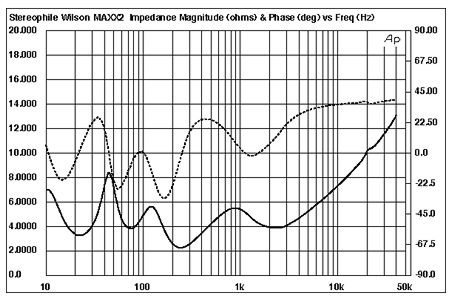
Fig.1 Wilson Audio Specialties MAXX2, electrical impedance (solid) and phase (dashed). (2 ohms/vertical div.)
The traces in fig.1 are free from the wrinkles that result from resonant modes in the enclosure panels, and I couldn't find any trace of such resonances in the walls of either the woofer bin or the head unit, proving the efficacy of Wilson's use of M and X composite materials. The small blip in the traces just above 20kHz suggests that the tweeter's dome resonance lies at a lower frequency than is usual for a metal-diaphragm unit.
The saddle just above 20Hz in the impedance magnitude trace suggests that this is the tuning frequency of the woofer bin's large, rear-facing port. Fig.2 shows that both the lower woofer (blue trace) and upper woofer (green) have minimum-motion notches at 25Hz in their responses, these due to the back pressure from the port resonance holding the cones still at this frequency. Both woofers roll off slowly above their nominal passband, though the midrange units increasingly dominate the speaker's output above 200Hz. The port's output (red) broadly peaks between 10Hz and 70Hz, implying excellent bass extension.

Fig.2 Wilson Audio Specialties MAXX2, nearfield midrange units (black trace), 10.5" woofer (green), 13" woofer (blue), and lower port (red) responses.
I haven't shown the output of the midrange enclosure's port, as this was so down in level, it doesn't contribute in any meaningful manner to the MAXX2's low-frequency output. (I suspect it is there more to maximize the midrange units' power handling.) Though the nearfield measurement technique used to generate the traces in this graph will exaggerate the apparent upper-bass output of the sound sources by 3dB or so, the fact that there are two woofers, each of which on its own looks as if it would provide sufficient output to match the midrange units, implies that the MAXX2's low frequencies will be generously balanced.
That this is the case is revealed by fig.3, which shows the complex sum of the nearfield responses in fig.2 below 300Hz. The midbass peaks up by 7dB, only half of which will be due to the measurement technique. Above 300Hz, fig.3 shows the Wilson's farfield response on an axis 36" from the floor, which is Michael's ear height. The overall trend in this graph is a mild sloping-down of the speaker's output from the midbass to the top octave, broken by a peak just below the transition region between the upper midrange and the low treble. The tweeter's diaphragm resonance also gives rise to a peak above 15kHz that might be just audible to young listeners.
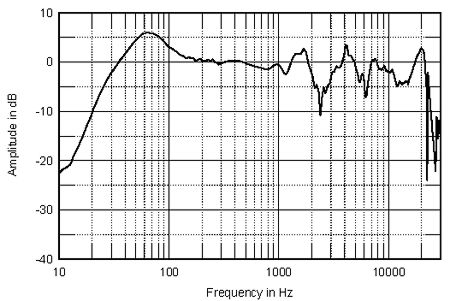
Fig.3 Wilson Audio Specialties MAXX2, anechoic response on axis 36" from the floor, corrected for microphone response, with the complex sum of the nearfield midrange, woofer, and port responses, taking into account acoustic phase and distance from the nominal farfield point, plotted below 300Hz.
The exact listening axis is very critical with the MAXX32, which is why the speaker array needs to be aimed so carefully at the listener's ears. Fig.4, for example, shows the speaker's response averaged across a 30º horizontal window on the lower-midrange axis, which is 46" from the floor. I chose this axis because it is where the upper-frequency drive-units seem to integrate best (see the step response). However, a large, narrow peak develops between 1.6kHz and 2.1kHz.
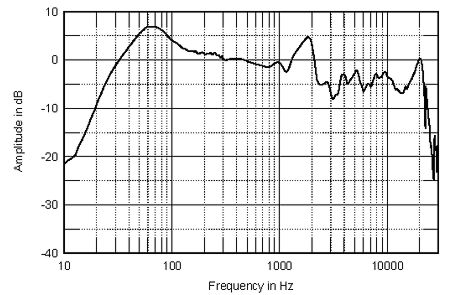
Fig.4 Wilson Audio Specialties MAXX2, anechoic response on axis level with lower midrange unit at 50", averaged across 30º horizontal window and corrected for microphone response, with the complex sum of the nearfield midrange, woofer, and port responses, taking into account acoustic phase and distance from the nominal farfield point, plotted below 300Hz.
The speaker's bulk made it impractical to get a serious look at its lateral off-axis behavior in detail. However, its on-axis output appears to be maintained without significant changes out to 15º to the side. In the vertical plane (fig.5), the mid-treble region shelves up a little above the lower-midrange axis, while the height of the upper-midrange peak decreases slightly at low microphone positions.
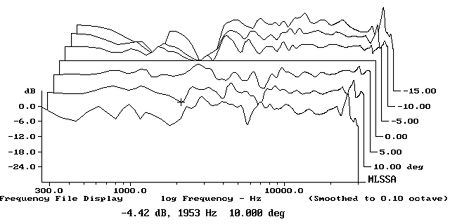
Fig.5 Wilson Audio Specialties MAXX2, vertical response family at 50", normalized to response on tweeter axis, from back to front: differences in response 15–5º above axis, reference response, differences in response 5–15º below axis.
Fig.6 was produced by measuring the 1/3-octave power spectrum for each speaker individually in MF's listening room at nine microphone positions arranged in a grid centered on the position of his ears. Averaging these spectra gives a curve that I have found correlates quite well with a speaker's perceived tonal balance. The MAXX2's powerfully extended low frequencies make their presence known in this graph, as does the excess of upper-midrange energy. I could hear the latter as a touch of nasality on pink noise, but it proved surprisingly less noticeable on music, though I'm sure it contributed to the Wilson's fine presentation of recorded detail. Other than those characteristics, the MAXX2's in-room balance is relatively smooth.
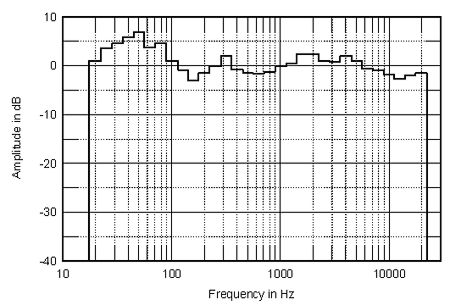
Fig.6 Wilson Audio Specialties MAXX2, 1/3-octave, spatially averaged response in MF's listening room.
In the time domain, the Wilson's step response on the lower-midrange axis (fig.7) suggests that, despite its complicated geometry, the MAXX2 is not a time-coincident design. The tweeter appears from this graph to be connected in positive acoustic polarity, the midrange units in inverted polarity, and the woofers in positive polarity (this confirmed by the units' individual step responses, not shown). The MAXX2 is time-coherent, however; each unit's step smoothly handing over to that of the next lower in frequency. This correlates with the good frequency-domain integration seen in fig.4.
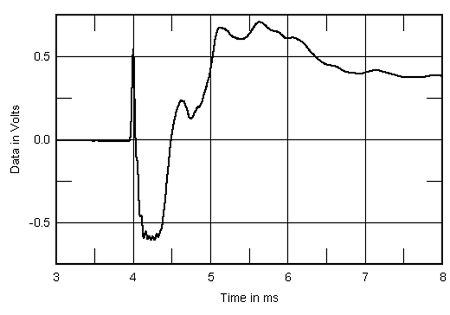
Fig.7 Wilson Audio Specialties MAXX2, step response on lower-midrange axis at 50" (5ms time window, 30kHz bandwidth).
The tail of the step in fig.7 can be seen to be overlaid with some ringing, this having a period less than 1ms. The MAXX2's cumulative spectral-decay plot, taken on the lower-midrange axis (fig.8), indicates that this ringing is associated with a broad ridge of delayed energy at 1.8kHz, the center of the elevated region seen in fig.4. Much of the other treble hash seen in this graph is due, I believe, to interference effects on this axis, but the 1.8kHz peak above the optimal listening axis appears to be real, resulting perhaps from the behavior of the relatively large midrange cones. But note the very clean decay of the tweeter in its top two octaves, correlating with the speaker's absence of HF grain.
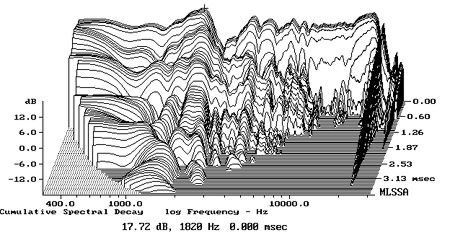
Fig.8 Wilson Audio Specialties MAXX2, cumulative spectral-decay plot at 50" (0.15ms risetime).
Some of the benefits of David Wilson's design philosophy, such as the MAXX2's undoubtedly low distortion and its high maximum loudness capability, go unremarked in my suite of measurements. However, the speaker's impressively extended and powerful low frequencies were evident, as was its relatively smooth in-room response—with the exception of the elevated upper midrange, which concerned me. But I must say that, measured performance aside, I was very impressed by what I heard in Mikey's listening room.—John Atkinson
- Log in or register to post comments




































